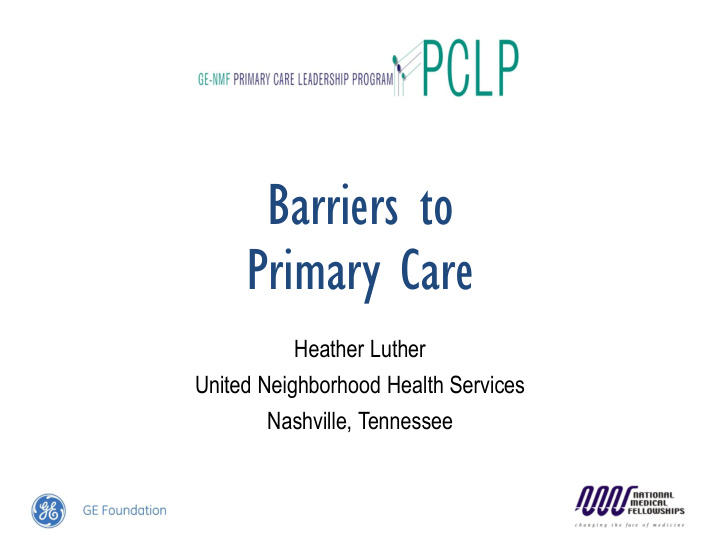



Barriers to Primary Care Heather Luther United Neighborhood Health Services Nashville, Tennessee
Introduction • This project had three objectives 1. Identify UNHS patient who previously faced barriers to primary care or who were underserved at the time of the project due to barriers to care. 2. Identify the most common barriers to care amongst these UNHS patients through direct interaction with them. 3. Develop a set of recommendations for more efficiently using existing resources and processes at UNHS to overcome the most common barriers to care and to target outreach to the broader community served by UNHS.
Background • Although there is a large body of research showing that members of socioeconomically disadvantaged communities face various barriers to primary health care, this project sought to validate this research through interactions with community members themselves.
Methodology • The project’s methodology was a patient survey that collected basic demographic information and asked three questions: • “ What are your two biggest health concerns? For example: high sugar, high blood pressure, heart, cancer, weight, etc.” • “ What are the two biggest barriers or problems to getting the health care you need? For example: transportation, financial, clinic hours, etc.” • “ What are two things we can do to help you have better health? For example: expanding clinic hours, cooking classes, exercise program, etc.” • Additionally, the survey concluded by asking the patients if they had any other suggestions or comments.
Results • Three health concerns that dwarfed all others in terms of frequency of response: • Weight (61%) • Diabetes or blood sugar (52%) • High blood pressure (45%). • 94% listed money or insurance as a barrier to care, and 48% listed both and no other barriers • However, UNHS offers primary care services regardless of a patient’s ability to pay
Discussion • Overall, this project finds that there are two kinds of barriers to primary health care, the immediate and the systemic. • Immediate barriers are those like a lack of insurance, transportation, or clinic hours. The survey responses showed these barriers. • Systemic barriers create a perception that it’s not worth it to seek primary health care in the first place because that will inevitably lead to a need for additional services and care that will be unattainable. These barriers were a subtext to the process of collecting data and the nature of the answers.
Recommendations • The first action that the survey results indicate would yield results is better communication to the community of the services that UNHS offers and their availability to all regardless of ability to pay. • UNHS serves patients regardless of ability to pay and has services focused on the most frequently mentioned health concerns. • To help overcome systemic barriers, UNHS could do more to offer affordable prescription drugs and partner with other organizations to facilitate a continuum of affordable and accessible care.
Conclusion • Although UNHS offers a wide spectrum of services regardless of one’s ability to pay, patients still see cost as a significant barrier to getting the health care that they need. UNHS could address this by better outreach to the community regarding their services and policies. • However, patients may also rightfully fear that any health care need they have beyond basic primary care, including prescription drugs, won’t be accessible because of their lack of insurance and resources, which may prevent them from seeking needed care. This is due to systemic problems in US health care that UNHS may be able to mitigate, but not solve.
Acknowledgements • Mr. Will Wyatt • Dr. Lois Wagner
Recommend
More recommend